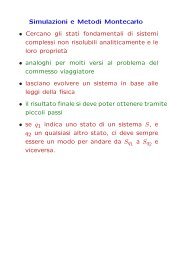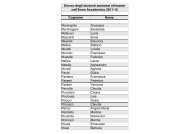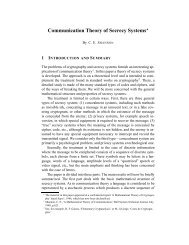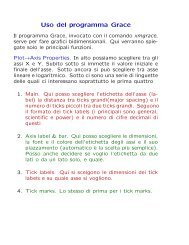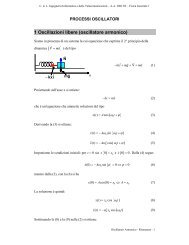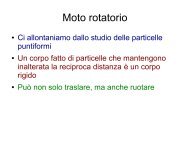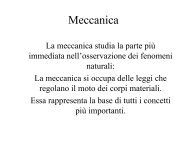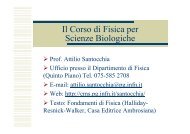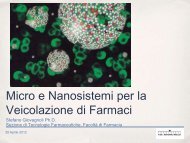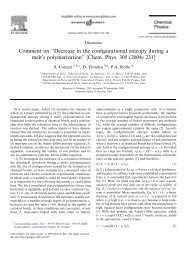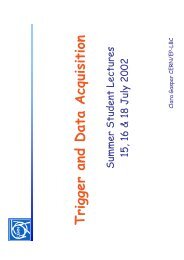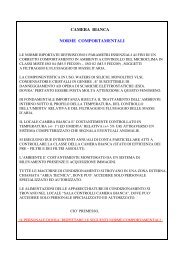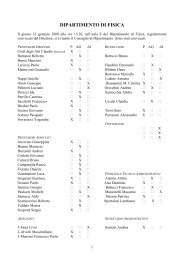Particle Detectors - Indico - Cern
Particle Detectors - Indico - Cern
Particle Detectors - Indico - Cern
You also want an ePaper? Increase the reach of your titles
YUMPU automatically turns print PDFs into web optimized ePapers that Google loves.
<strong>Particle</strong> <strong>Detectors</strong><br />
History of Instrumentation ↔ History of <strong>Particle</strong> Physics<br />
The ‘Real’ World of <strong>Particle</strong>s<br />
Interaction of <strong>Particle</strong>s with Matter<br />
Tracking <strong>Detectors</strong>, Calorimeters, <strong>Particle</strong> Identification<br />
Detector Systems<br />
W. Riegler/CERN<br />
Summer Student Lectures 2010<br />
Werner Riegler, CERN, werner.riegler@cern.ch<br />
1
Detector Physics<br />
Precise knowledge of the processes leading to signals in particle<br />
detectors is necessary.<br />
The detectors are nowadays working close to the limits of theoretically<br />
achievable measurement accuracy – even in large systems.<br />
Due to available computing power, detectors can be simulated to within 5-<br />
10% of reality, based on the fundamental microphysics processes (atomic<br />
and nuclear crossections).<br />
W. Riegler/CERN<br />
2
Electric Fields in a Micromega Detector<br />
Electrons avalanche multiplication<br />
W. Riegler/CERN<br />
<strong>Particle</strong> Detector Simulation<br />
Very accurate simulations<br />
of particle detectors are<br />
possible due to availability of<br />
Finite Element simulation<br />
programs and computing power.<br />
Follow every single electron by<br />
applying first principle laws of<br />
physics.<br />
For Gaseous <strong>Detectors</strong>:<br />
GARFIELD by R. Veenhof<br />
Electric Fields in a Micromega Detector<br />
3
I) C. Moore’s Law:<br />
Computing power doubles 18 months.<br />
II) W. Riegler’s Law:<br />
The use of brain for solving a problem<br />
is inversely proportional to the available<br />
computing power.<br />
I) + II) = ...<br />
W. Riegler/CERN<br />
<strong>Particle</strong> Detector Simulation<br />
Knowing the basics of particle detectors is essential …<br />
4
Interaction of <strong>Particle</strong>s with Matter<br />
Any device that is to detect a particle must interact with it in<br />
some way almost …<br />
In many experiments neutrinos are measured by missing<br />
transverse momentum.<br />
E.g. e + e - collider. P tot=0,<br />
If the Σ p i of all collision products is ≠0 neutrino escaped.<br />
Claus Grupen, <strong>Particle</strong> <strong>Detectors</strong>, Cambridge University Press, Cambridge 1996 (455 pp. ISBN 0-521-55216-8)<br />
W. Riegler/CERN<br />
5
Interaction of <strong>Particle</strong>s with Matter<br />
W. Riegler/CERN 6
Electromagnetic Interaction of <strong>Particle</strong>s with Matter<br />
M, q=Z 1 e 0<br />
Interaction with the<br />
atomic electrons. The<br />
incoming particle<br />
loses energy and the<br />
atoms are excited or<br />
ionized.<br />
Z 2 electrons, q=-e 0<br />
Interaction with the<br />
atomic nucleus. The<br />
particle is deflected<br />
(scattered) causing<br />
multiple scattering of<br />
the particle in the<br />
material. During this<br />
scattering a<br />
Bremsstrahlung<br />
photon can be emitted.<br />
In case the particle’s velocity is larger<br />
than the velocity of light in the medium,<br />
the resulting EM shockwave manifests<br />
itself as Cherenkov Radiation. When the<br />
particle crosses the boundary between<br />
two media, there is a probability of the<br />
order of 1% to produced and X ray<br />
photon, called Transition radiation.<br />
7/15/2010 W. Riegler, <strong>Particle</strong> <strong>Detectors</strong> 7
While the charged particle is passing another charged particle, the Coulomb Force<br />
is acting, resulting in momentum transfer<br />
The relativistic form of the transverse electric field doesn’t change the momentum<br />
transfer. The transverse field is stronger, but the time of action is shorter<br />
The transferred energy is then<br />
F<br />
x<br />
Ionization and Excitation<br />
b<br />
The incoming particle transfer energy only (mostly) to the atomic electrons !<br />
7/15/2010 W. Riegler, <strong>Particle</strong> <strong>Detectors</strong><br />
8
Ionization and Excitation<br />
Target material: mass A, Z 2, density [g/cm 3 ], Avogadro number N A<br />
A gramm N A Atoms: Number of atoms/cm 3 n a =N A /A [1/cm 3 ]<br />
Number of electrons/cm 3 n e =N A Z 2/A [1/cm 3 ]<br />
With E(b) db/b = -1/2 dE/E E max= E(b min) E min = E(b max)<br />
E min I (Ionization Energy)<br />
7/15/2010 W. Riegler, <strong>Particle</strong> <strong>Detectors</strong><br />
9
1)<br />
2)<br />
1+2)<br />
Relativistic Collision Kinematics, E max<br />
7/15/2010 W. Riegler, <strong>Particle</strong> <strong>Detectors</strong><br />
10<br />
θ<br />
φ
Classical Scattering on Free Electrons<br />
This formula is up to a factor 2 and the<br />
density effect identical to the precise<br />
QM derivation <br />
Bethe Bloch Formula 1/<br />
W. Riegler/CERN<br />
Electron Spin<br />
Density effect. Medium is polarized<br />
Which reduces the log. rise.<br />
11
Small energy loss<br />
Fast <strong>Particle</strong><br />
Discovery of muon and pion<br />
W. Riegler/CERN<br />
Cosmis rays: dE/dx α Z 2<br />
Small energy loss<br />
Fast particle<br />
Pion<br />
Pion<br />
Pion<br />
Large energy loss<br />
Slow particle<br />
Kaon<br />
12
For Large the medium is being polarized by the<br />
strong transverse fields, which reduces the rise of<br />
the energy loss density effect<br />
At large Energy Transfers (delta electrons) the<br />
liberated electrons can leave the material.<br />
In reality, E max must be replaced by E cut and the<br />
energy loss reaches a plateau (Fermi plateau).<br />
Characteristics of the energy loss as a function<br />
of the particle velocity ( )<br />
The specific Energy Loss 1/ρ dE/dx<br />
• first decreases as 1/ 2<br />
• increases with ln for =1<br />
• is independent of M (M>>m e)<br />
• is proportional to Z 1 2 of the incoming particle.<br />
• is independent of the material (Z/A const)<br />
• shows a plateau at large (>>100)<br />
•dE/dx 1-2 x ρ [g/cm 3 ] MeV/cm<br />
W. Riegler/CERN<br />
Bethe Bloch Formula<br />
Energy Loss by Excitation and Ionization<br />
1/<br />
Für Z>1, I 16Z 0.9 eV<br />
13
Bethe Bloch Formula, a few Numbers:<br />
For Z 0.5 A<br />
1/ dE/dx 1.4 MeV cm 2 /g for ßγ 3<br />
Example :<br />
Iron: Thickness = 100 cm; ρ = 7.87 g/cm 3<br />
dE ≈ 1.4 * 100* 7.87 = 1102 MeV<br />
A 1 GeV Muon can traverse 1m of Iron<br />
W. Riegler/CERN<br />
Bethe Bloch Formula<br />
Energy Loss by Excitation and Ionization<br />
1/<br />
This number must be multiplied<br />
with ρ [g/cm 3 ] of the Material <br />
dE/dx [MeV/cm]<br />
14
Energy Loss as a Function of the Momentum<br />
Energy loss depends on the particle<br />
velocity and is ≈ independent of the<br />
particle’s mass M.<br />
The energy loss as a function of particle<br />
Momentum P= Mcβγ IS however<br />
depending on the particle’s mass<br />
By measuring the particle momentum<br />
(deflection in the magnetic field) and<br />
measurement of the energy loss on can<br />
measure the particle mass<br />
<strong>Particle</strong> Identification !<br />
W. Riegler/CERN<br />
Energy Loss by Excitation and Ionization<br />
15
Energy Loss as a Function of the Momentum<br />
Measure momentum by<br />
curvature of the particle<br />
track.<br />
Find dE/dx by measuring<br />
the deposited charge<br />
along the track.<br />
<strong>Particle</strong> ID<br />
W. Riegler/CERN 16
<strong>Particle</strong> of mass M and kinetic Energy E 0 enters matter and looses energy until it<br />
comes to rest at distance R.<br />
Bragg Peak:<br />
For >3 the energy loss is <br />
constant (Fermi Plateau)<br />
If the energy of the particle<br />
falls below =3 the energy<br />
loss rises as 1/ 2<br />
Towards the end of the track<br />
the energy loss is largest <br />
Cancer Therapy.<br />
W. Riegler/CERN<br />
Range of <strong>Particle</strong>s in Matter<br />
Independent of<br />
the material<br />
Energy Loss by Excitation and Ionization<br />
17
Average Range:<br />
Towards the end of the track the energy loss is largest Bragg Peak <br />
Cancer Therapy<br />
Relative Dose (%)<br />
W. Riegler/CERN<br />
Range of <strong>Particle</strong>s in Matter<br />
Photons 25MeV Carbon Ions 330MeV<br />
Depth of Water (cm)<br />
Energy Loss by Excitation and Ionization<br />
18
7/15/2010<br />
Luis Alvarez used<br />
the attenuation of<br />
muons to look for<br />
chambers in the<br />
Second Giza<br />
Pyramid Muon<br />
Tomography<br />
He proved that<br />
there are no<br />
chambers present.<br />
W. Riegler, <strong>Particle</strong> 19
7/15/2010<br />
Intermezzo: Crossection<br />
Crossection : Material with Atomic Mass A and density contains<br />
n Atoms/cm 3<br />
E.g. Atom (Sphere) with Radius R: Atomic Crossection = R 2 <br />
A volume with surface F and thickness dx contains N=nFdx Atoms.<br />
The total ‘surface’ of atoms in this volume is N .<br />
The relative area is p = N /F = N A /A dx =<br />
Probability that an incoming particle hits an atom in dx.<br />
What is the probability P that a particle hits an atom between distance x and x+dx ?<br />
P = probability that the particle does NOT hit an atom in the m=x/dx material layers and that the<br />
particle DOES hit an atom in the m th layer<br />
Mean free path<br />
Average number of collisions/cm<br />
F<br />
dx<br />
20
Differential Crossection:<br />
Crossection for an incoming particle of energy E to lose an energy between E’ and E’+dE’<br />
Total Crossection:<br />
Probability P(E) that an incoming particle of Energy E loses an energy between E’ and E’+dE’<br />
in a collision:<br />
Average number of collisions/cm causing an energy loss between E’ and E’+dE’<br />
Average energy loss/cm:<br />
7/15/2010<br />
W. Riegler, <strong>Particle</strong><br />
Intermezzo: Differential Crossection<br />
21
Fluctuation of Energy Loss<br />
Up to now we have calculated the average energy loss. The energy loss is<br />
however a statistical process and will therefore fluctuate from event to event.<br />
x=0 x=D<br />
E <br />
E - <br />
X X X X X<br />
XX X X<br />
X X X<br />
XXX X XX<br />
X XXX X<br />
P() = ? Probability that a particle loses an energy when traversing a material of<br />
thickness D<br />
We have see earlier that the probability of an interaction ocuring between distance x<br />
and x+dx is exponentially distributed
Probability for n Interactions in D<br />
We first calculate the probability to find n interactions in D, knowing that the probability to<br />
find a distance x between two interactions is P(x)dx = 1/ exp(-x/) dx with = A/ N A
For an interaction with a mean free path of , the probability for n interactions on a distance D<br />
is given by<br />
Poisson Distribution !<br />
Probability for n Interactions in D<br />
If the distance between interactions is exponentially distributed with an mean free path of λ<br />
the number of interactions on a distance D is Poisson distributed with an average of n=D/λ.<br />
How do we find the energy loss distribution ?<br />
If f(E) is the probability to lose the energy E’ in an interaction, the probability p(E) to lose an<br />
energy E over the distance D ?
Probability f(E) for loosing energy between E’ and E’+dE’ in a single interaction is<br />
given by the differential crossection d (E,E’)/dE’/ (E) which is given by the<br />
Rutherford crossection at large energy transfers<br />
d (E,E’)/dE’/ (E)<br />
Excitation and ionization<br />
W. Riegler/CERN<br />
Fluctuations of the Energy Loss<br />
Energy Loss by Excitation and Ionization<br />
Scattering on free electrons<br />
P(E,)<br />
25
Landau Distribution<br />
P(): Probability for energy loss <br />
in matter of thickness D.<br />
Landau distribution is very<br />
asymmetric.<br />
Average and most probable<br />
energy loss must be<br />
distinguished !<br />
Measured Energy Loss is usually<br />
smaller that the real energy loss:<br />
3 GeV Pion: E’ max = 450MeV A<br />
450 MeV Electron usually leaves<br />
the detector.<br />
W. Riegler/CERN<br />
Landau Distribution<br />
Energy Loss by Excitation and Ionization<br />
26
LANDAU DISTRIBUTION OF ENERGY LOSS:<br />
Counts 4 cm Ar-CH4 (95-5)<br />
6000<br />
5 bars<br />
4000<br />
2000<br />
0<br />
N = 460 i.p.<br />
0 500 1000<br />
N (i.p.)<br />
For a Gaussian distribution: N ~ 21 i.p.<br />
FWHM ~ 50 i.p.<br />
W. Riegler/CERN<br />
Landau Distribution<br />
FWHM~250 i.p.<br />
PARTICLE IDENTIFICATION<br />
Requires statistical analysis of hundreds of samples<br />
Counts<br />
6000<br />
4000<br />
2000<br />
Energy Loss by Excitation and Ionization<br />
0<br />
protons electrons<br />
15 GeV/c<br />
0 500 1000<br />
N (i.p)<br />
I. Lehraus et al, Phys. Scripta 23(1981)727<br />
27
‘average’ energy loss<br />
In certain momentum ranges,<br />
particles can be identified by<br />
measuring the energy loss.<br />
W. Riegler/CERN<br />
<strong>Particle</strong> Identification<br />
Energy Loss by Excitation and Ionization<br />
Measured energy loss<br />
28
7/15/2010<br />
Bremsstrahlung<br />
A charged particle of mass M and charge q=Z 1e is deflected by a nucleus of charge Ze<br />
which is partially ‘shielded’ by the electrons. During this deflection the charge is<br />
‘accelerated’ and it therefore radiated Bremsstrahlung.<br />
M, q=Z 1 e 0<br />
Z 2 electrons, q=-e 0<br />
W. Riegler, <strong>Particle</strong> 29
Bremsstrahlung, Classical<br />
A charged particle of mass M and<br />
charge q=Z 1e is deflected by a<br />
nucleus of Charge Ze.<br />
Because of the acceleration the<br />
particle radiated EM waves <br />
energy loss.<br />
Coulomb-Scattering (Rutherford<br />
Scattering) describes the deflection<br />
of the particle.<br />
Maxwell’s Equations describe the<br />
radiated energy for a given<br />
momentum transfer.<br />
dE/dx<br />
W. Riegler/CERN 30
Bremsstrahlung, QM<br />
Proportional to Z 2 /A of the Material.<br />
Proportional to Z 1 4 of the incoming<br />
particle.<br />
Proportional to of the material.<br />
Proportional 1/M 2 of the incoming<br />
particle.<br />
Proportional to the Energy of the<br />
Incoming particle <br />
E(x)=Exp(-x/X 0) – ‘Radiation Length’<br />
X 0 M 2 A/ ( Z 1 4 Z 2 )<br />
X 0: Distance where the Energy E 0 of<br />
the incoming particle decreases<br />
E 0Exp(-1)=0.37E 0 .<br />
W. Riegler/CERN 31
Electron Momentum 5 50 500 MeV/c<br />
Critical Energy: If dE/dx (Ionization) = dE/dx (Bremsstrahlung)<br />
Myon in Copper: p 400GeV<br />
Electron in Copper: p 20MeV<br />
Critical Energy<br />
For the muon, the second<br />
lightest particle after the<br />
electron, the critical<br />
energy is at 400GeV.<br />
The EM Bremsstrahlung is<br />
therefore only relevant for<br />
electrons at energies of<br />
past and present<br />
detectors.<br />
W. Riegler/CERN 32
W. Riegler/CERN<br />
Pair Production, QM<br />
For E>>m ec 2 =0.5MeV : = 9/7X 0<br />
Average distance a high energy<br />
photon has to travel before it<br />
converts into an e + e - pair is<br />
equal to 9/7 of the distance that a<br />
high energy electron has to<br />
travel before reducing it’s energy<br />
from E 0 to E 0*Exp(-1) by photon<br />
radiation.<br />
33
Bremsstrahlung + Pair Production EM Shower<br />
W. Riegler/CERN<br />
34
W. Riegler/CERN<br />
Statistical (quite complex) analysis of multiple collisions gives:<br />
Probability that a particle is defected by an angle after travelling a<br />
distance x in the material is given by a Gaussian distribution with sigma of:<br />
X 0 ... Radiation length of the material<br />
Z 1 ... Charge of the particle<br />
p ... Momentum of the particle<br />
Multiple Scattering<br />
35
Magnetic Spectrometer: A charged particle describes a circle in a magnetic field:<br />
W. Riegler/CERN<br />
Multiple Scattering<br />
Limit Multiple Scattering<br />
36
W. Riegler/CERN<br />
Multiple Scattering<br />
37
W. Riegler/CERN<br />
ATLAS Muon Spectrometer:<br />
N=3, sig=50um, P=1TeV,<br />
L=5m, B=0.4T<br />
Multiple Scattering<br />
∆p/p ~ 8% for the most energetic muons at LHC<br />
38
M, q=Z 1 e 0<br />
Cherenkov Radiation<br />
If we describe the passage of a charged particle through material of dielectric<br />
permittivity (using Maxwell’s equations) the differential energy crossection is >0<br />
if the velocity of the particle is larger than the velocity of light in the medium is<br />
N is the number of Cherenkov Photons emitted per cm of material. The expression<br />
is in addition proportional to Z 1 2 of the incoming particle.<br />
The radiation is emitted at the characteristic angle c , that is related to the<br />
refractive index n and the particle velocity by<br />
39
Cherenkov Radiation<br />
40
Ring Imaging Cherenkov Detector (RICH)<br />
There are only ‘a few’ photons per<br />
event one needs highly sensitive<br />
photon detectors to measure the<br />
rings !<br />
W. Riegler/CERN 41
LHCb RICH<br />
W. Riegler/CERN 42
M, q=Z 1 e 0<br />
7/15/2010<br />
Z 2 electrons, q=-e 0<br />
Transition Radiation<br />
When the particle crosses the boundary between two media,<br />
there is a probability of the order of 1% to produced and X ray<br />
photon, called Transition radiation.<br />
43
Transition Radiation<br />
W. Riegler/CERN 44
Electromagnetic Interaction of <strong>Particle</strong>s with Matter<br />
Ionization and Excitation:<br />
Charged particles traversing material are exciting and ionizing the atoms.<br />
The average energy loss of the incoming particle by this process is to a good<br />
approximation described by the Bethe Bloch formula.<br />
The energy loss fluctuation is well approximated by the Landau distribution.<br />
Multiple Scattering and Bremsstrahlung:<br />
The incoming particles are scattering off the atomic nuclei which are partially shielded<br />
by the atomic electrons.<br />
Measuring the particle momentum by deflection of the particle trajectory in the<br />
magnetic field, this scattering imposes a lower limit on the momentum resolution of<br />
the spectrometer.<br />
The deflection of the particle on the nucleus results in an acceleration that causes<br />
emission of Bremsstrahlungs-Photons. These photons in turn produced e+e- pairs in<br />
the vicinity of the nucleus, which causes an EM cascade. This effect depends on the<br />
2 nd power of the particle mass, so it is only relevant for electrons.<br />
7/15/2010<br />
45
Electromagnetic Interaction of <strong>Particle</strong>s with Matter<br />
Cherenkov Radiation:<br />
If a particle propagates in a material with a velocity larger than the speed of light in this<br />
material, Cherenkov radiation is emitted at a characteristic angle that depends on the<br />
particle velocity and the refractive index of the material.<br />
Transition Radiation:<br />
If a charged particle is crossing the boundary between two materials of different<br />
dielectric permittivity, there is a certain probability for emission of an X-ray photon.<br />
The strong interaction of an incoming particle with matter is a process which is<br />
important for Hadron calorimetry and will be discussed later.<br />
7/15/2010<br />
46
Electromagnetic Interaction of <strong>Particle</strong>s with Matter<br />
M, q=Z 1 e 0<br />
Interaction with the<br />
atomic electrons. The<br />
incoming particle<br />
loses energy and the<br />
atoms are excited or<br />
ionized.<br />
7/15/2010<br />
Z 2 electrons, q=-e 0<br />
Now that we know all the Interactions we can talk about <strong>Detectors</strong> !<br />
Interaction with the<br />
atomic nucleus. The<br />
particle is deflected<br />
(scattered) causing<br />
multiple scattering of<br />
the particle in the<br />
material. During this<br />
scattering a<br />
Bremsstrahlung<br />
photon can be emitted.<br />
In case the particle’s velocity is larger<br />
than the velocity of light in the medium,<br />
the resulting EM shockwave manifests<br />
itself as Cherenkov Radiation. When the<br />
particle crosses the boundary between<br />
two media, there is a probability of the<br />
order of 1% to produced and X ray<br />
photon, called Transition radiation.<br />
47
Now that we know all the Interactions we can talk about <strong>Detectors</strong> !<br />
W. Riegler/CERN 48



